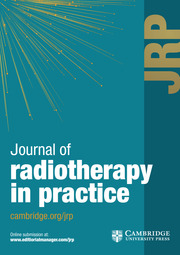Article contents
A study for the dosimetric evaluation of rotational setup error forlung stereotactic body radiation therapy*
Published online by Cambridge University Press: 01 August 2018
Abstract
To investigate the necessity of rotational shifts by considering dosimetricimpact of rotational errors on stereotactic body radiation therapy(SBRT).
20 lung patients with the lesion size <5 cm treated with SBRT havebeen selected for dosimetric analysis. Three-dimensional dose has beenrotationally shifted (±1°, ±3°,±5° for pitch, roll and yaw) and overlaid to the originalcomputed tomography images. The dose–volume histograms of18-rotational plans of each patient were compared to those of the originalplan.
No significant dosimetric differences were observed in target coverage. Forall of the cases up to 5° in any couch angle dose differences ofD99 and D95 were<3%. Variations of conformity index were observed to be lessthan 0·05. None of the organ at risk doses exceeded the dose limit.The V20 differences of the ipsilateral and thetotal lungs were less than 0·4%.
It has been found to be unnecessary to perform rotational shifts up to5° for lung SBRT treatments; the translational shift is sufficientfor the cases used in this study. This method may be applied and testedafter planning and before treatment initiation to rule out exceptionallyextreme cases.
Information
- Type
- Original Article
- Information
- Copyright
- © Cambridge University Press 2018
Footnotes
This article was originally published with Minsik Lee listed as the soleauthor. This has now been corrected and the other authors added. Acorrigendum with the full explanation can be found at https://doi.org/10.1017/S146039691900075X.
Cite this article: Mossahebi S, Langner U, Prado K, Lee M and Yi B. (2018) A study for the dosimetricevaluation of rotational setup error for lung stereotactic bodyradiation therapy. Journal of Radiotherapy in Practice17: 420–424. doi: 10.1017/S1460396918000250
References
A correction has been issued for this article:
- 3
- Cited by
Linked content
Please note a has been issued for this article.

